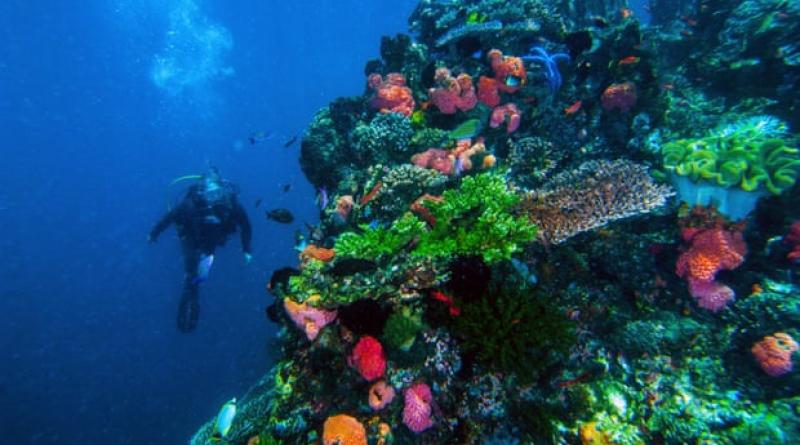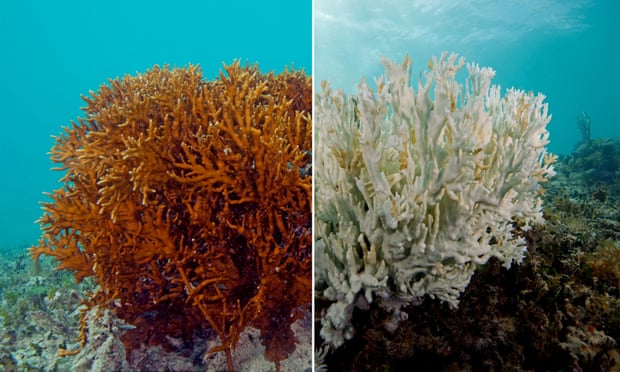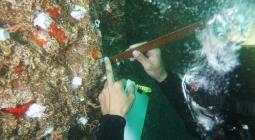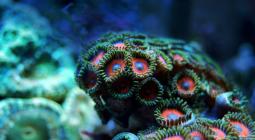Why there is hope that the world's coral reefs can be saved.

From coral farming to 3D printing, scientists are using novel methods to save a vital part of our ecosystem.
For most of us, the colourful, otherworldly marinescapes of coral reefs are as remote as the alien landscapes of the moon. We rarely, if ever, experience these underwater wonderlands for ourselves – we are, after all, air-breathing, terrestrial creatures mostly cocooned in cities. It is easy, therefore, not to notice the perilous state they’re in: we’ve lost 50% of coral reefs in the past 20 years; more than 90% are expected to die by 2050 according to a presentation at the Ocean Sciences Meeting in San Diego, California earlier this year. As the oceans heat further and turn more acidic, owing to rising carbon dioxide emissions, coral reefs are tipped to become the world’s first ecosystems to become extinct because of us.
Just because we don’t see them doesn’t mean we won’t miss them. For, as we are belatedly discovering, the nice, dry human world that we’ve made for ourselves is dependent on the planet’s natural systems and coral reefs are no exception. They protect our coastlands from erosion, they are the nurseries for the fish we eat and they harbour the plankton that produce the oxygen we breathe. Globally, coral reefs support a quarter of all marine life and the livelihoods of a billion people.
Coral reefs are ancient and highly adaptable – they first emerged nearly 500 million years ago; those corals went extinct, and the corals that we have now first appeared 240 million years ago. The difference now is the extreme pace of change. Coral is slow growing and a reef takes about 10 years to recover fully after a single bleaching event. By 2049, we are expecting annual bleaching events in the tropics, pushing reefs beyond recovery. It’s a grim prospect and one of the reasons that in 2015 the world’s nations pledged to limit global warming to 1.5C above preindustrial levels, a temperature that would enable coral reefs to survive. It remains far from clear whether we will meet this goal.
However, while we still have reefs, we still have hope. Some will do better than others – some already are – and scientists are trying to work out why in a bid to build resilience elsewhere. As with climate change, human activity is implicated. For instance, studies show that reefs are more likely to recover from a heating event if they are protected from other stresses, such as overfishing, pollution from agriculture and boat damage.

With the future of the world’s ecological and human systems now so deeply interconnected, a new movement in reef conservation is putting social systems at its heart and explicitly building resilience into human and ecological systems in tandem. In other words, protecting nature means protecting people. The Coral Reef Alliance, for instance, is working with reef-dependent fishing communities in Honduras. Overfishing hits reefs in a number of ways, including by removing herbivores, such as parrotfish, whose grazing constrains coral-damaging algae. The non-governmental organisation helps with boat purchases for reef patrols, providing salaried key positions on the ground and helping diversify income streams so people are less reliant on exploiting vulnerable ecosystems.
g. But can we provide them with alternatives for when there’s a fisheries closure to protect the reef, so they can still provide food and an income for their families,” says Madhavi Colton, the director of the Coral Reef Alliance. “We’re building resilience in the human community and that translates to resilience in the coral reef community as well.”
The organisation uses economic indicators as well as data collected by scientists in the community, which is then presented back to the community. “So they’ve been able to see that the fish stocks are increasing because of their actions,” Colton says.
A key test was this from March to April, when their lagoons off the island of Roatan were protected with a one-month closure. “This year, with Covid-19, we weren’t sure if the community was going to want to do that. But because they’ve seen such dramatic increases in biomass after closures in past years, they decided to,” Colton says. “We’re building community support for regulations by showing how they benefit the community.”
The organisation is also reforesting inland to reduce sediment flows and has built a wastewater treatment facility. Colton says: “We estimate we’ve prevented around 28.5m gallons of sewage from being directly discharged on to the reef. And as a result of that facility, the public beach in West End was given a flag for safe swimming by US standards.”
The hope is that by building resilience, coral reefs and the communities that depend on them will be able to adapt and survive if the climate stabilises. And, if the worst happens, it should help people adjust to living with an extinct reef. Unesco is piloting a similar community-focused initiative called Resilient Reefs, after finding that 21 of its 29 World Heritage-listed coral reef sites were already degraded.

Meanwhile, in Australia’s Great Barrier Reef, which has lost half of its corals in the past five years, an innovative project is putting the tourism industry, which is 90% reliant on the reef, at the heart not just of reef protection, but of actively healing the reef on which it depends. David Suggett, associate professor at the University of Technology Sydney, says: “We’re trying to build a more sustainable and resilient reef economy, by equipping workers with the skills and tools to propagate corals from the good parts of the reef to help rebuild the poor parts of the reef, so that the ecosystem they rely on for their livelihoods is retained.”
Suggett’s coral nurture programme, which has been running for four years, relies on coral gardening, which was first developed in the Caribbean after disease nearly wiped out the only three species of native Acropora (hard, branching) corals there. That laborious process involved gluing fragments of living coral from healthy parts of the reef on to dead coral skeletons or artificial reef structures. The idea is to hasten a natural process whereby coral fragments or polyps are carried on currents and fix themselves on a reef, repopulating it. The expense and time-consuming nature of such projects means they’ve been largely dismissed, but the method has proved worth the efforts in the Caribbean: this year, Acropora saved from the brink of extinction actually began natural spawning.
Now, Suggett’s team have designed a coral clip that’s safer than glue – and much faster to apply. “Tour operators can clip several hundred coral fragments on to the reef in each dive – each takes seconds – and within one to two months, the coral naturally glues itself on to the reef and starts growing. The clip just degrades over time.”
The scale of the operation has meant the team have had to create nurseries to supply a stock of corals, by propagating parent lines. They also use “coral IVF”, collecting eggs and sperm and fertilising them away from predators until they grow into baby corals that can be injected back on to the reef in a controlled manner. Suggett explains: “So you bypass that really early stage where everything’s really susceptible to getting eaten.”
The project gives tour operators resilience, enabling them to be much more adaptive in the face of change, he adds. “This year, during Covid-19 when tourism shut down overnight, the tour operators who were equipped with the new tools and workflows for coral gardening were able to repurpose their businesses and ride out the downturn, while others closed.”
Just as diversification builds resilience for livelihoods, so it is essential for reef ecosystems, and reef networks connected by ocean currents, to allow migrating larvae move and adapt. Malin Pinsky, associate professor at Rutgers University, New Jersey, who led one recent study, says: “We found that a diversity of reef types provides the variety that evolution depends on. We need to conserve hot sites, which are important sources of heat-tolerant corals, as well as colder sites that can become important future habitats.”
He adds that corals are already migrating in the directions of the poles, showing up in Japan, in places that used to be covered in kelp, and in southern Australia, “which is another sign of hope”.
In the face of profound global change, it’s not enough to simply protect reefs from stress: active intervention and adaptation is required, from coral gardening to physically removing coral predators, such as crown-of-thorns starfish. Others want to intervene further by selectively implanting heat-tolerant varieties, including lab-grown polyps, or even using Crispr, a rapid gene-editing technology, to produce genetically engineered versions. In 2019, researchers described 23 different ways to improve the resilience and persistence of coral reefs.
“It took several years for us to get a permit to experimentally move heat-tolerant corals from hot mangrove lagoons out to the reefs, a journey that polyps could make naturally,” says Suggett. “So it will take some time before corals are allowed to be introduced from elsewhere.”
Those experiments showed that heat-adapted corals can thrive in new environments and could be an important source of reef regeneration.
One place to look would be the Gulf of Aqaba in the northern Red Sea. Due to a quirk of geology, the corals there have evolved adapted to harsh hot conditions, with the result that they are not simply heat-tolerant, they thrive better as the water heats, growing faster. Karine Kleinhaus, an associate professor at Stony Brook University, New York, says: “Most corals struggle to survive temperatures just 1C above the summer maximum, but Aqaba corals are super-thermally resilient, even in acidic waters, and cope with temperatures 6C – even 7C – hotter.”
She believes these corals represent a precious and unique population – they could be the last coral reefs standing at the end of the century. And yet they are currently poorly protected, threatened by pollution and rampant coastal development, which compromises their resilience.
What coral reefs are experiencing right now amounts to a massive evolutionary selection pressure, something that Michael Webster, a research scientist at New York University who, unusually, is confident they’ll get through. He says: “Take the northern Great Barrier Reef, with three years of back-to-back bleaching. In some places, 70% of the coral was lost. What that means is 30% of the coral survived, perhaps because it is more tolerant. Those are the corals that produce the next generation, which inherits some of those traits,” he says. Indeed, one study showed that coral that survived bleaching on the Great Barrier Reef in 2016 had twice the average heat tolerance the following year. Separate lab research reveals that corals can pass on their adaptive strategies to their offspring.
Timing is everything, though. When coral dies or is destroyed, the reef shrinks,a problem exacerbated by current sea level rise, making it harder for new corals to grow because their habitat is depth-specific. And when you lose a coral reef, you are losing the entire ecosystem, not simply a few species of coral. It means we need to ask hard questions about what we value in our reefs and what we are trying to protect in terms of functionality.
Implanting thermal extremophiles, such as corals from Aqaba, could speed up the evolutionary process of heat adaptation, but means dramatically changing the ecosystem – the opposite of traditional conservation – and comes with risks. Artificial – even 3D printed – reefs can provide structure and researchers are even experimenting with artificial reef noise. Using underwater loudspeakers to play the sounds of a healthy reef in degraded areas has been shown to attract fish populations back to the area, helping to kickstart recovery of the ecosystem.
“For evolution to occur quickly usually requires a lot of death: that is the natural selection signal. Right now, we’re in the ugly beginning of that process,” Webster says. “I believe a lot of corals are going to get through this bottleneck, they’re not going to go extinct, they’re going to figure out a way to pace with climate change, so long as we give them some room.”
In other words, it will depend on good reef management and whether humanity can get a handle on climate change. Given the scale of bleaching globally, it’s a brave prediction – let’s hope he’s right.
Why are coral reefs so threatened by the climate crisis?
Coral reefs are facing an unprecedented threat from global carbon dioxide emissions, chiefly because of hotter oceans and acidification as the atmospheric gas dissolves into seawater.
Coral exists in a mutually beneficial relationship with zooxanthellae algae, which live inside the coral’s polyps. The algae use the coral’s waste products and provide the nutrients to feed them both through photosynthesis. Higher sea temperatures force the coral to expel the colourful algae and, if this process is prolonged, the coral starves.
During a coral bleaching event, reefs lose so much zooxanthellae that they become white and experience massive die-offs. Ocean acidification exacerbates the problem, eroding the reef, forcing corals to expend more energy building their calcium carbonate skeletons and slowing down their growth rate.
The average global temperature is already 1C hotter than in preindustrial times. In addition, climate change is intensifying periodic weather phenomena, such as El Niño warming events, increasing the temperatures reefs experience and reducing the recovery interval between bleaching events. Climate models predict that global heating will continue over the coming century because our carbon emissions are expected to continue rising. Some 75% of tropical reefs were hit by bleaching during a global ocean heatwave between 2014 and 2017. Half of tropical coral reefs have been lost during the past three decades and even if temperatures were kept no higher than 1.5C, between 70% and 90% of reefs would be lost by the end of the century.
18 October 2020





